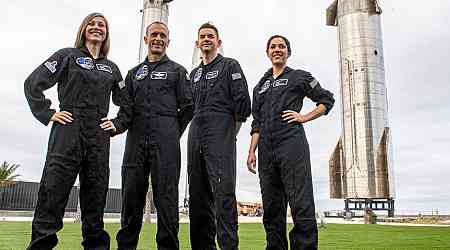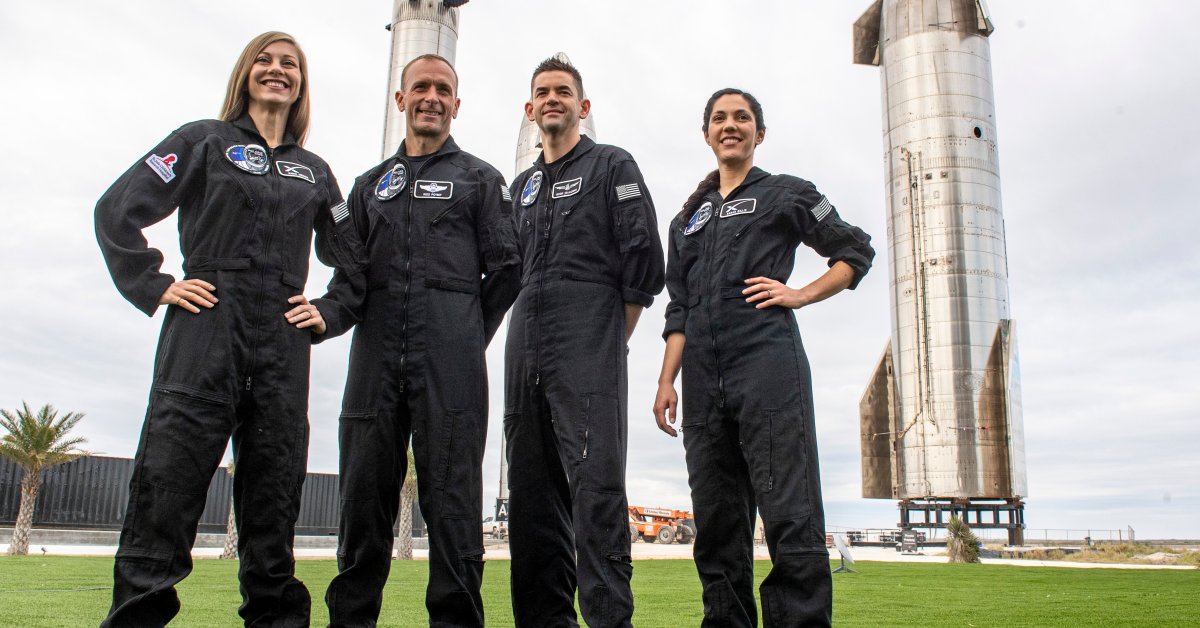 [time-brightcove not-tgx=”true”]
[time-brightcove not-tgx=”true”]It was a very big deal on Sept. 14, 1966, when astronauts Pete Conrad and Dock Gordon flew their Gemini XI spacecraft to a never-before-attained altitude of 850 miles. It’s still a big deal 58 years later, since that record for a crewed spacecraft in Earth orbit remains. But that will change later this month, when the crewmembers of the Polaris Dawn mission—set for launch on Aug. 26—fire their thrusters and climb to a new benchmark of 870 miles, venturing farther from home than any astronauts on any non-lunar mission have ever traveled.
The Polaris Dawn crew will notch other achievements too—becoming the first commercial astronauts to perform extravehicular activity (EVA, also known as a spacewalk), and the first to test communications between a spacecraft and the satellites that make up the SpaceX Starlink system. They will also conduct a suite of more than 40 scientific experiments, testing the SpaceX Dragon spacecraft at altitudes that take it through the Van Allen radiation belts, and also performing more than a dozen experiments on the crewmembers themselves, including exploring what to do about the stubborn problem of space motion sickness, which is experienced by 60% to 80% of all space travelers during their first two or three days off the Earth. In addition, they hope to raise tens of millions of dollars for St. Jude Children’s Research Hospital.

The mission is bankrolled by Jared Isaacman, the billionaire founder and CEO of Shift4, an internet payment company. It will be Isaacman’s second trip to space, after the all-civilian mission of Inspiration4, in September of 2021. That journey too raised a lot of money for St. Jude, Isaacman’s favorite charity, and marked the first time an all-civilian crew journeyed spaceward. For both missions, Isaacman was effectively a paying customer of SpaceX, buying seats aboard the Dragon at a reported $50 million each. Polaris Dawn has a bigger mission, kicking off the first of three flights in the Polaris series, which could see private crews perform maintenance on the Hubble Space Telescope, and also fly aboard the inaugural mission of SpaceX’s massive Starship rocket.
“We named the Polaris program after our North Star,” says Isaacman, “which is actually a constellation of three stars, and Polaris is contemplated to be three missions.”
Isaacman could be on all of those Polaris flights, which, after Inspiration4, will give him a total of four trips into space, making him one of the world’s most experienced astronauts—despite his never having been part of NASA or any other governmental space program. His crew the first time around was noteworthy for its inclusion of Hayley Arceneaux, then 29, a physician assistant at St. Jude, who had been treated there for bone cancer when she was a child, and became the first person to fly in space with a prosthetic—a rod in place of her left femur. This time around, the crew includes pilot Scott Poteet, a retired Air Force lieutenant colonel, and vice president of strategy at Shift4; mission specialist Sarah Gillis, a lead space operations engineer at SpaceX; and mission specialist and medical officer Anna Menon, another SpaceX lead space operations engineer.
For all of the contributions to science the Polaris series could make, it is the possibility of servicing Hubble and raising its altitude to a higher, longer lasting orbit that might be the greatest. Hubble has been aloft since 1990, and in the decades since, it has established itself as one of the most important cosmic observatories ever built. Five servicing missions conducted by space-shuttle crews helped extend its useful life, but since the shuttles stood down in 2011, the telescope has always been just one breakdown away from going offline for good. A new servicing mission by a new crew could keep it in operation for years to come.
“There’s been a study jointly conducted with SpaceX, Polaris, and NASA, on the feasibility of boosting Hubble,” says Isaacman. “[It’s] a pretty easy risk-reward ratio in my mind.”
Flying the maiden mission of Starship—which would happen on the third mission—would be no small thing either. The spacecraft has been selected by NASA for use as its Human Landing System—the lunar module for the Artemis program, which aims to have astronauts back on the moon before the end of this decade. Only a handful of NASA giants have commanded first missions in a new spacecraft—Alan Shepard in Mercury, Gus Grissom in Gemini, Wally Schirra in Apollo, and John Young in the shuttles. Whoever flies Starship on its first Earth orbital mission will be in rarefied company.
But Polaris Dawn will be the first out of the gate for the Polaris series, and it has manifold jobs to do. The business of conducting medical tests—including performing head tilts while spinning in the spacecraft—to puzzle out the stubborn problem of space sickness, could go a long way toward making space habitation and settlement more practical. Astronauts have been suffering from motion sickness since the first humans flew in space, and no one has ever come up with a good solution beyond administering antiemetics and other drugs.
“You can’t have this great SpaceX vision of putting hundreds of thousands of people in space if half of them are throwing up, because the other half are going to throw up too,” says Isaacman. “That’s certainly something that has to be conquered for a species that evolved in 1g,” or normal gravity.
More immediately, the Polaris Dawn crew will also be the first to try out a new, more robust spacesuit design. Not only will it protect astronauts when they’re inside a nominally pressurized spacecraft, but also when they’re in the hard vacuum and extreme temperatures encountered during EVAs and on the surface of the moon. Like the old Apollo lunar suits, the new ones are rugged and allow for outdoor mobility—but unlike the old suits, they are also comfortable.
“One of the things you have to consider is oftentimes you introduce hard joint points around the suit,” says Menon. “If you’re sitting in a seat with restraints on, you can actually hurt the person inside with that. So SpaceX has developed this really novel joint design that, when a suit is unpressurized, actually becomes like a soft joint. On the EVA, Sarah and Jared will gather great data on the suit performance.”
The Starlink work could be groundbreaking too. More than 6,200 Starlink satellites are currently in orbit, and up to 42,000 could eventually be deployed. The system, which has most famously been used by both Ukraine and Russia in their ongoing war, provides broadband service from the sky to the ground, but has not been used to date between two spacecraft. Polaris Dawn will run a proof-of-concept experiment establishing that it can be done.
“We are adding a laser to the trunk of Dragon,” says Gillis. “In order to communicate and send internet to the spacecraft, you have a laser directing information [from Starlink], and then another laser returning information to that moving constellation at all times. It’s incredible bandwidth availability.”
Life aboard Dragon during the five-day Polaris Dawn mission will be relatively comfortable. The four-person spacecraft has a habitable volume of 328 cubic ft., somewhat roomier per person than the three-person, 210 cubic ft. Apollo. In orbit, that volume goes further still, since a weightless crew can make use of ceiling and bulkhead room that is not available in 1g.
The crew’s food will be better and fresher than commonplace astronaut food too—at least for the first two and a half days. “The fresh-food options include little sandwiches, pizza slices, and empanadas before you get into Clif Bars, beef jerky, and stuff like that,” says Poteet. The crew will have cold-brew coffee as well, which will serve a dual purpose—frozen into pouches that will be used to keep the fresh food cool, and becoming potable once the pouches thaw.
An earthly audience will be able to follow the mission as it unfolds—with liftoff, EVA, splashdown and other segments broadcast live. Menon, who is the mother of two small children, has co-authored a children’s book titled Kisses From Space, about a cosmic dragon and her terrestrial babies, which she will read from orbit. Copies of the book are being sold on the Polaris Dawn site and the one she takes to orbit will be auctioned off, with all proceeds going to St. Jude.
There may be music from space as well. During Inspiration4, crewmember Chris Sembroski played the ukulele for viewers at home. Polaris Dawn’s Gillis is a classically trained violinist and may be taking her instrument to space with her. “Some secrets I’m going to keep,” she says with a laugh.
Menon and the other crewmembers, of course, take little about their mission lightly. The journey will require lifting off atop a 23-story Falcon 9 rocket generating 1.7 million pounds of thrust, and flying a 13,228-pound Dragon around the world at 17,500 miles per hour—or 4.9 miles per second. A lot can go wrong with that thrust, weight, and speed. The men and women who will fly the Polaris missions know that they will be taking their chances—chances in the interests of high adventure, yes, but solid science too.

























